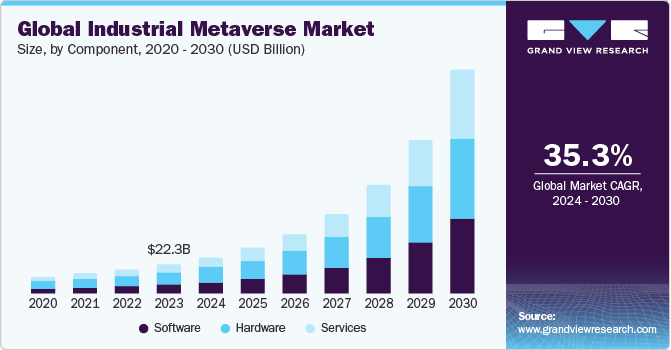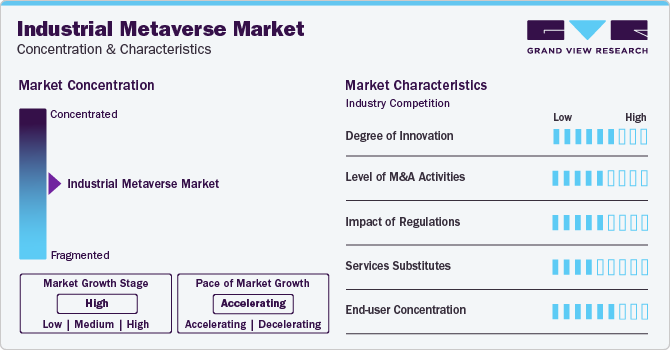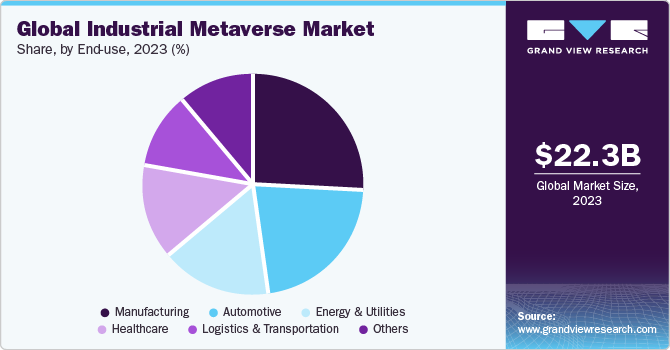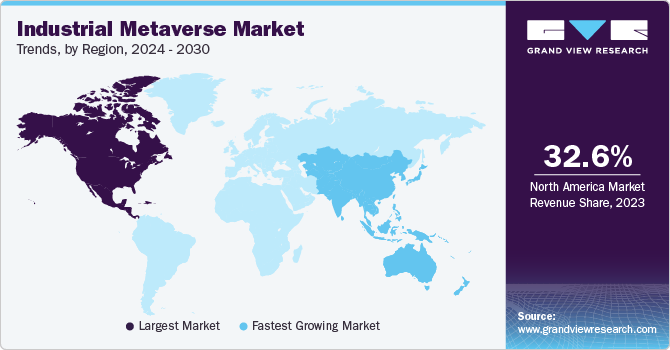- Home
- »
- Next Generation Technologies
- »
-
Industrial Metaverse Market Size And Share Report 2030GVR Report cover
![Industrial Metaverse Market Size, Share & Trends Report]()
Industrial Metaverse Market Size, Share & Trends Analysis Report By Component (Software, Hardware), By Technology, By Application, By End-use, By Region, And Segment Forecasts, 2024 - 2030
- Report ID: GVR-4-68040-129-8
- Number of Report Pages: 150
- Format: PDF, Horizon Databook
- Historical Range: 2017 - 2022
- Forecast Period: 2024 - 2030
- Industry: Technology
Industrial Metaverse Market Size & Trends
The global industrial metaverse market size was estimated at USD 22.35 billion in 2023 and is expected to grow at a CAGR of 35.3% from 2024 to 2030. The integration of digital twins has significantly enriched the market, offering virtual representations of physical assets and processes that drive efficiency and innovation. By enabling real-time monitoring, predictive analytics, and simulation capabilities, digital twins empower industrial metaverses to optimize operations, enhance productivity, and minimize risks. This technology promotes seamless collaboration and decision-making across diverse industrial sectors, propelling the evolution of interconnected virtual environments.

The adoption of digital twins continues to expand; they are becoming integral tools for businesses seeking to thrive in an increasingly digitalized world. For instance, in March 2023, L&T Technology Services Limited, an Indian multinational technology company, collaborated with Ansys, Inc., an American multinational company, to establish a Center of Excellence for Digital Twin dedicated to advancing the adoption of digital twin solutions in manufacturing and industrial sectors. Their collaboration aims to promote innovation and improve operational efficiency within these industries.
VR (Virtual Reality) and AR (Augmented Reality) technologies enhance the industrial metaverse by offering immersive training experiences, remote assistance, advanced visualization, safety training, and remote monitoring capabilities. These technologies enable employees to engage in realistic simulations, improving learning outcomes and reducing skill acquisition time. AR applications facilitate remote assistance and collaboration, enhancing troubleshooting and maintenance processes. VR tools simplify design and visualization, reducing development costs and identifying design flaws early. Moreover, VR and AR are utilized in safety training programs to simulate hazardous scenarios, improving safety awareness and emergency response preparedness. Additionally, AR-enabled smart devices provide technicians with real-time data during maintenance tasks, enhancing efficiency and accuracy. Overall, VR and AR technologies contribute significantly to productivity, safety, and innovation within the industrial metaverse.
The focus on developing next-generation nuclear reactors highlights the adoption of advanced technologies within the market. These technologies enable engineers to create virtual models of reactors, optimize design parameters, and ensure safety and efficiency. AI algorithms analyze operational data in real time, enhancing predictive maintenance and optimizing reactor performance, and data analytics provide valuable insights for decision-making and regulatory compliance. Companies are collaborating to utilize innovative solutions such as advanced simulation tools, artificial intelligence, and data analytics to address complex industrial challenges and drive sustainable growth. For instance, in February 2024, Dassault Systemes and Assystem, an independent engineering group based in Paris, strengthened their strategic partnership to expedite the development of next-generation nuclear reactors. By utilizing digital twins, this partnership aims to assist industry customers in managing project complexity and ensuring data quality and traceability for design and delivery.
Market Concentration & Characteristics
Companies within the market are pioneering the adoption of transformative solutions such as virtual reality (VR), augmented reality (AR), artificial intelligence (AI), digital twins, and the Internet of Things (IoT). These advanced technologies serve as the building blocks for creating immersive simulations that mirror real-world industrial processes, propelling innovation across various sectors. From design and prototyping to production processes, supply chain management, predictive maintenance, and workforce training, the market offers a vast array of opportunities for companies to optimize operations and drive sustainable growth. This environment thrives on a culture of innovation, where businesses continuously explore new possibilities, experiment with emerging technologies, and adapt to evolving market demands.

In the market, merger and acquisition strategies are crucial for companies seeking to enhance their technological capabilities and extend their market reach. Through strategic acquisitions or mergers, companies can gain access to advanced technologies, specialized expertise, and established customer bases that are essential for success in this rapidly evolving sector. For instance, in March 2023, NVIDIA Corporation collaborated with Microsoft to expedite the adoption of enterprise-grade generative AI. NVIDIA Corporation is integrating its AI Enterprise software into Microsoft Azure Machine Learning, empowering enterprises to accelerate AI initiatives with over 100 NVIDIA AI frameworks and tools. This collaboration offers a secure platform on Azure for creating, deploying, and managing customized AI applications, utilizing high-performance NVIDIA accelerated computing resources.
The impact of regulation on the market can be significant, influencing various aspects of its development and adoption. Regulations may affect areas such as data privacy, cybersecurity, intellectual property rights, safety standards, and environmental regulations. Compliance with regulatory requirements is essential for companies operating within the market to ensure legal adherence, protect consumer rights, and mitigate risks. Additionally, regulatory frameworks can shape industry standards, drive innovation, and promote market stability. However, overly restrictive regulations may also hinder technological advancement, limit market growth, and create barriers to entry for smaller companies.
Substitutes for the market include traditional industrial technologies and practices that do not fully harness advanced digital solutions. This could involve reliance on manual processes, legacy systems, or non-digital solutions for tasks such as maintenance, training, and design. Some companies opt for traditional consulting services or in-house development instead of adopting digital platforms for predictive maintenance or supply chain optimization. While these substitutes may suffice for some companies in the short term, they need more efficiency, scalability, or competitive advantage offered by the advanced digital solutions provided by the market.
End user concentration is a defining characteristic of the market, as an increasing number of enterprises and sectors adopt its transformative technologies. Some of the industries driving this concentration include automotive, healthcare, logistics and transportation, manufacturing, energy and utilities, and others. This end-user base influences market dynamics transforms demand for advanced digital solutions and drives innovation within the industrial metaverse ecosystem.
Component Insights
The hardware segment dominated the market with the largest share of 41.9% in 2023. Industrial metaverse solutions often require specialized hardware components customized to the unique needs of industrial applications. These may include ruggedized devices capable of withstanding harsh operating conditions, high-performance computing systems for real-time data processing, and specialized sensors for monitoring industrial processes. Hardware advancements enable the implementation of advanced capabilities within the industrial metaverse, such as immersive VR/AR experiences, real-time monitoring and control, and high-fidelity digital twins. As these technologies become more sophisticated and widely adopted, the demand for compatible hardware grows accordingly.
The services segment is projected to grow significantly over the forecast period. Industrial metaverse solutions often require customization and integration with existing systems and processes within industrial environments. Service providers offer expertise in tailoring solutions to meet the specific needs of each client, ensuring seamless integration and optimal performance. Once deployed, industrial metaverse solutions require ongoing maintenance and support to ensure continuous operation and optimal performance. Service providers offer maintenance contracts, remote monitoring, and troubleshooting services to address issues promptly and minimize downtime.
Technology Insights
The VR segment dominated the market with the largest share in 2023. The VR segment dominates the market due to its ability to provide immersive experiences and promote realistic training simulations for industrial tasks. Moreover, VR enables virtual product design and prototyping, accelerating the design iteration process and reducing time-to-market. It also supports remote collaboration among geographically dispersed teams and enhances data visualization and analysis capabilities, particularly valuable for industries such as manufacturing. As VR technology continues to advance and become more accessible, its role in transforming industrial processes and operations is expected to grow further.
The MR segment is predicted to foresee significant growth in the forecast period. MR combines elements of both virtual and augmented reality, offering users a seamless blend of virtual and real-world environments, which enhances user engagement and interaction. MR technology enables hands-on training and simulations in real-world settings, enabling users to interact with digital content overlaid onto physical objects, making it particularly valuable for tasks that require spatial awareness and manipulation. Moreover, MR facilitates remote assistance and collaboration by enabling users to share and interact with digital content in real time, regardless of their physical location. Furthermore, MR enhances product design and prototyping processes by enabling designers to visualize and manipulate virtual models within real-world contexts, leading to faster iteration cycles and improved design outcomes.
Application Insights
The data visualization & analytics segment dominated the market with the largest share in 2023. As industrial processes become increasingly digitized, there is a growing volume of data generated across various operations. Data visualization and analytics tools enable companies to make sense of this data by transforming complex datasets into visual representations that are easier to understand and interpret. Moreover, in the industrial metaverse, these tools enable users to visualize and analyze data within immersive virtual environments, providing valuable insights into operational performance, equipment health, and production efficiency. As companies strive to optimize processes and improve decision-making, there is a growing demand for advanced analytics capabilities that can uncover patterns, trends, and anomalies within industrial datasets. Additionally, data visualization and analytics tools enable real-time monitoring and predictive analytics, empowering companies to identify and address issues proactively, leading to increased efficiency and reduced downtime.
The product design & development segment is projected to grow significantly over the forecast period. VR and AR technologies enable engineers and designers to create immersive virtual environments where they can visualize and manipulate digital prototypes in real time. This immersive experience facilitates more efficient collaboration among design teams, leading to faster iteration cycles and improved design outcomes. Virtual prototyping reduces the need for physical prototypes, saving time and resources in the product development process. Additionally, VR and AR technologies allow designers to evaluate product designs within real-world contexts, enabling them to identify and address potential issues before physical production begins. The industrial metaverse facilitates remote collaboration among geographically dispersed teams, enabling seamless communication and coordination throughout the product development lifecycle.
End-use Insights
The manufacturing segment dominated the market with the largest share in 2023. Manufacturing is witnessing growth in the market due to its integration of digital technologies such as VR, AR, and digital twins. These technologies enhance operational efficiency and productivity by simplifying production workflows, optimizing equipment utilization, and minimizing downtime through predictive maintenance and real-time monitoring. The industrial metaverse promotes remote collaboration and knowledge sharing among geographically dispersed teams, enabling faster decision-making and enhancing overall agility in responding to market demands. Virtual prototyping and simulation within the industrial metaverse enable manufacturers to design and optimize production processes in a virtual environment, reducing the need for costly physical prototypes and minimizing risks associated with product development.

The automotive segment is projected to grow significantly over the forecast period. The industrial metaverse promotes the optimization of automotive supply chains by providing real-time visibility into inventory levels, production processes, and logistics operations. This enables automotive companies to simplify supply chain management, reduce costs, and improve overall efficiency. The automotive industry is increasingly focused on developing advanced driver assistance systems and autonomous vehicle technologies. The industrial metaverse provides a platform for testing and validating these technologies in virtual environments, enabling automotive companies to accelerate innovation and improve safety features. Moreover, the industrial metaverse enhances aftermarket services and maintenance for automotive vehicles by providing virtual diagnostics, remote assistance, and predictive maintenance capabilities. This improves vehicle reliability, reduces downtime, and enhances the overall ownership experience for customers.
Regional Insights
North America dominated the market and accounted for a 32.6% share in 2023. North America has a strong industrial base across various sectors, including manufacturing, automotive, aerospace, and healthcare, among others. These industries are early adopters of industrial metaverse technologies, utilizing them to enhance productivity, efficiency, and innovation in their operations. Moreover, North America benefits from a robust infrastructure for digital connectivity, including high-speed internet networks and advanced data centers. This infrastructure enables seamless integration and deployment of industrial metaverse solutions, facilitating real-time collaboration, data sharing, and analysis across geographically dispersed locations.

The U.S. Industrial Metaverse Market Trends
The industrial metaverse market in the U.S. is expected to grow with a CAGR of 31.0% from 2024 to 2030. The U.S. industrial metaverse market is witnessing a significant integration of advanced technologies such as VR, AR, artificial intelligence, and digital twins. This integration enables companies to create immersive and data-driven environments for enhanced productivity and innovation across various industries.
Europe Industrial Metaverse Market Trends
The industrial metaverse market in Europe is growing, as the adoption of Industry 4.0 principles is setting the pace for digital transformation within the manufacturing and industrial sectors. In the industrial metaverse market, European companies are utilizing technologies such as VR, AR, and digital twins to drive innovation and improve efficiency.
The UK industrial metaverse market benefits from a dynamic research and development ecosystem, with prestigious universities, research institutions, and technology hubs leading the charge in driving innovation. Collaborative endeavors among academia, industry, and government bodies are instrumental in advancing advanced metaverse technologies and solution.
The industrial metaverse market in Germany is positively impacted by the government's recognition of its potential, prompting active investments in research and development. This includes funding programs specifically customized for companies engaged in the development of industrial metaverse applications.
Asia Pacific Industrial Metaverse Market Trends
The industrial metaverse market in Asia Pacific is anticipated to register the fastest CAGR over the forecast period. The rise of smart manufacturing and Industry 4.0 initiatives in the region is driving the adoption of advanced technologies, including the industrial metaverse. Companies are increasingly focused on digital transformation and are investing in technologies that enable real-time monitoring, predictive maintenance, and data-driven decision-making. The rapid expansion of e-commerce and the increasing digitalization of consumer behavior in the Asia Pacific is opening up new avenues for the integration of metaverse technologies. Specifically, these developments present opportunities for immersive virtual shopping experiences, enhanced product visualization, and engaging interactive marketing campaigns.
The China industrial metaverse market is expected to grow significantly over the forecast period. As China continues to prioritize industrial modernization and digital transformation initiatives, the demand for metaverse solutions to enhance productivity is expected to rise. Moreover, the growing interest and investment from domestic and international players in the Chinese metaverse market further contribute to its projected growth.
The industrial metaverse market in India is expected to grow substantially over the forecast period. The Indian government is actively pushing for a digital economy. Initiatives like "Digital India" aim to increase internet penetration and promote technological adoption, paving the way for the metaverse.
Middle East & Africa (MEA) Industrial Metaverse Market Trends
In the MEA region, specific sectors such as oil & gas, construction, and manufacturing are spearheading the adoption of industrial metaverse technologies, driven by their intricate operational demands and the promise of significant efficiency enhancements. Within the oil & gas sector, firms are harnessing virtual reality simulations for training in hazardous environments and utilizing augmented reality for remote maintenance and inspections of offshore assets. Similarly, in the construction domain, the incorporation of digital twins and augmented reality-based project visualization tools promotes better collaboration among stakeholders.
Key Industrial Metaverse Company Insights
Prominent firms have used product launches and developments, followed by expansions, mergers and acquisitions, contracts, agreements, partnerships, and collaborations as their primary business strategy to increase their market share. The companies have used various techniques to enhance market penetration and boost their position in the competitive industry. For instance, in October 2023, Microsoft has broadened its collaboration with Siemens to extend the advantages of generative AI across global industries. Siemens introduces the Siemens Industrial Copilot, an AI-powered assistant aimed at improving cooperation between humans and machines in manufacturing. Additionally, the collaboration involves integrating Siemens Teamcenter software with Microsoft Teams, facilitating smooth virtual collaboration for design engineers and frontline workers.
Key Industrial Metaverse Companies:
The following are the leading companies in the industrial metaverse market. These companies collectively hold the largest market share and dictate industry trends.
- Bentley Systems, Inc.
- Dassault Systems SE
- HTC Corporation
- Magic Leap, Inc.
- Microsoft Corporation
- NVIDIA Corporation
- PTC Inc
- Siemens AG
- Swanson Analysis Systems Inc.
- Unity Software Inc.
Recent Developments
-
In February 2024, Dassault Systems SE and Bayerische Motoren Werke AG, a German multinational manufacturer of luxury vehicles, have initiated a long-term strategic partnership to utilize the 3DEXPERIENCE platform in BMW Group's future engineering platform, involving over 17,000 employees. The partnership aims to simplify collaboration and manage the complexity of connected, autonomous vehicle engineering, optimizing engineering processes and delivering personalized and sustainable experiences to customers.
-
In January 2024, Ansys Inc. introduced Ansys SimAI, an AI-powered SaaS application to transform engineering workflows by combining simulation accuracy with generative AI speed. This launch aims to accelerate performance prediction, enabling rapid analysis and reducing time-to-market for product development.
-
In October 2023, Microsoft has extended its partnership with Rockwell Automation, Inc., an automation company in the U.S., to accelerate the design and development of industrial automation systems using generative artificial intelligence. By combining technologies, they aim to empower the workforce and reduce time-to-market for customers building industrial automation systems.
-
In March 2023, In March 2023, HTC Corporation announced development of a Vive Tracker accessory, utilizing inside-out tracking technology without the need for external beacons, enhancing body tracking in VR experiences. This standalone tracker supports various applications, including VR, PC VR, and non-VR uses, such as object tracking, with compatibility across different headset platforms.
Industrial Metaverse Market Report Scope
Report Attribute
Details
Market size value in 2024
USD 27.75 billion
Revenue forecast in 2030
USD 170.11 billion
Growth Rate
CAGR of 35.3% from 2024 to 2030
Base year for estimation
2023
Historical data
2017 - 2022
Forecast period
2024 - 2030
Report updated
May 2024
Quantitative units
Revenue in USD million/billion and CAGR from 2024 to 2030
Report coverage
Revenue forecast, company ranking, competitive landscape, growth factors, and trends
Segments covered
Component, technology, application, end-use, region
Regional scope
North America; Europe; Asia Pacific; Latin America; MEA
Country scope
U.S.; Canada; UK; Germany; France; China; Japan; India; South Korea; Australia; Brazil; Mexico; Kingdom of Saudi Arabia (KSA); UAE; South Africa
Key companies profiled
Bentley Systems, Inc.; Dassault Systems SE; HTC Corporation; Magic Leap, Inc.; Microsoft Corporation; NVIDIA Corporation; PTC Inc; Siemens AG; Swanson Analysis Systems Inc.; Unity Software Inc.
Customization scope
Free report customization (equivalent up to 8 analysts working days) with purchase. Addition or alteration to country, regional & segment scope.
Pricing and purchase options
Avail customized purchase options to meet your exact research needs. Explore purchase options
Global Industrial Metaverse Market Report Segmentation
This report forecasts revenue growth at global, regional, and country levels and provides an analysis of the latest industry trends in each of the sub-segments from 2017 to 2030. For this study, Grand View Research has segmented the global industrial metaverse market report based on component, technology, application, end-use, and region:
-
Component Outlook (Revenue, USD Billion, 2017 - 2030)
-
Software
-
Hardware
-
Services
-
-
Technology Outlook (Revenue, USD Billion, 2017 - 2030)
-
AR
-
VR
-
MR
-
-
Application Outlook (Revenue, USD Billion, 2017 - 2030)
-
Product Design & Development
-
Virtual Prototyping
-
Training & Simulation
-
Remote Collaboration
-
Maintenance & Repair
-
Supply Chain Optimization
-
Data Visualization & Analytics
-
-
End-use Outlook (Revenue, USD Billion, 2017 - 2030)
-
Automotive
-
Healthcare
-
Logistics & Transportation
-
Manufacturing
-
Energy and utilities
-
Others
-
-
Regional Outlook (Revenue, USD Billion, 2017 - 2030)
-
North America
-
U.S.
-
Canada
-
-
Europe
-
Germany
-
UK
-
France
-
-
Asia Pacific
-
China
-
Japan
-
India
-
South Korea
-
Australia
-
-
Latin America
-
Brazil
-
Mexico
-
-
Middle East and Africa (MEA)
-
Kingdom of Saudi Arabia
-
UAE
-
South Africa
-
-
Frequently Asked Questions About This Report
b. The global industrial metaverse market size was estimated at USD 22.35 billion in 2023 and is expected to reach USD 27.75 billion in 2024.
b. The global industrial metaverse market is expected to grow at a compound annual growth rate of 35.3% from 2024 to 2030 to reach USD 170.11 billion by 2030.
b. North America dominated the industrial metaverse market with a share of 32.60% in 2023. Due to thriving innovation hubs and proactive regulatory initiatives, North America is witnessing rapid industrial metaverse adoption and fostering cross-industry collaboration.
b. Some key players operating in the industrial metaverse market include Bentley Systems, Inc., Dassault Systems SE, HTC Corporation, Magic Leap, Inc., Microsoft Corporation, NVIDIA Corporation, PTC Inc, Siemens AG, Swanson Analysis Systems Inc., Unity Software Inc.
b. Key factors that are driving the market growth include Digital twin adoption is a key driver, enabling real-time simulation and analysis of physical assets in a virtual environment. AR and VR technologies are key components of the industrial metaverse, providing immersive experiences and hands-on training.
Share this report with your colleague or friend.
![gvr icn]()
NEED A CUSTOM REPORT?
We can customize every report - free of charge - including purchasing stand-alone sections or country-level reports, as well as offer affordable discounts for start-ups & universities. Contact us now
![Certified Icon]()
We are GDPR and CCPA compliant! Your transaction & personal information is safe and secure. For more details, please read our privacy policy.
We are committed towards customer satisfaction, and quality service.
"The quality of research they have done for us has been excellent."





